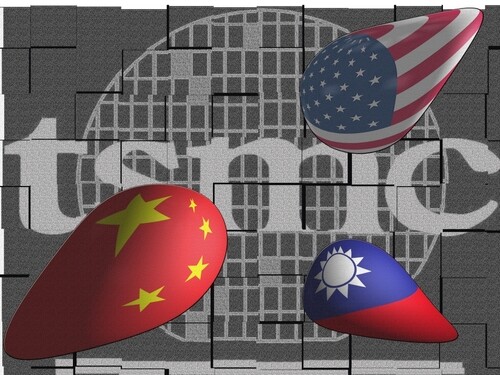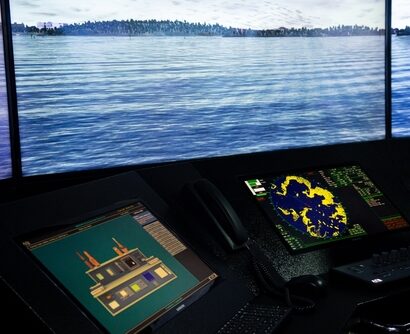Abstract: Taiwan occupies a pivotal position in the realm of technological geopolitics due to its dominance in semiconductor manufacturing and strategic location in the Indo-Pacific region. As global powers increasingly depend on advanced technologies for economic and security imperatives, Taiwan has emerged as a critical player in the strategic calculus of nations like the United States, China, and their allies. While these powers emphasise the One-China Policy in their diplomatic engagements, their growing collaboration with Taiwan inadvertently intensifies China’s aggressive stance toward the island. This dynamic underscores Taiwan’s dual role as both a bridge and a flashpoint in global strategic competition.
Problem statement: How does Taiwan’s role in technological geopolitics influence the strategic competition among major powers?
So what?: Policymakers and global stakeholders must prioritise creating frameworks that address Taiwan’s security concerns, promote peaceful cooperation, and mitigate regional tensions.

Source: shutterstock.com/Ricky kuo
A New Arena for Global Power Competition
In the 21st century, the geopolitics of technology has become pivotal in the global competition among major powers. As technological advances increasingly shape economic power, national security, and global influence, countries are not only vying for military supremacy but also dominance in the realm of cutting-edge technologies.[1] This competition is driven by the understanding that control over key technologies, such as artificial intelligence, 5G networks, cybersecurity, and quantum computing, can determine a nation’s strategic position on the global stage.[2]
As technological advances increasingly shape economic power, national security, and global influence, countries are not only vying for military supremacy but also dominance in the realm of cutting-edge technologies.
The United States (U.S.), the People’s Republic of China (PRC), and the European Union (EU), for example, are all investing heavily in emerging technologies to enhance their economic competitiveness and maintain national security. The PRC’s “Made in China 2025” initiative, aimed at transforming the country into a technological powerhouse, exemplifies its ambition to challenge Western dominance in key sectors.[3] Similarly, the U.S. views technological leadership as crucial for maintaining global influence and actively fosters innovation through public and private sector collaboration.
Competition is not just about technological prowess but also about shaping global standards and regulations. Major powers seek to influence the global governance of new technologies to create frameworks that reflect their values and priorities. The battle over the 5G network, with companies like Huawei at the centre, is a perfect example of how technology has become intertwined with national security and geopolitical rivalries. In essence, the geopolitical competition among major powers in the 21st century is increasingly defined by who controls and shapes the technologies of tomorrow. As technology continues to play an essential role in economic growth, military capabilities, and global influence, it will remain a central driver of global power struggles.[4]
Taiwan’s Strategic Semiconductor Role
Taiwan, home to the world’s most advanced semiconductor manufacturing capabilities, has emerged as a focal point in the technological and geopolitical competition among major powers. At the heart of this dynamic lies the Taiwan Semiconductor Manufacturing Company (TSMC), which produces over 90% of the world’s most advanced chips.[5] These semiconductors are indispensable for various critical technologies, from consumer electronics to artificial intelligence and military systems.
As the U.S., the PRC, and other major powers vie for technological supremacy, Taiwan’s strategic importance has grown exponentially. However, this increased attention has come with risks. While countries navigate their cooperation with Taiwan under the framework of the One-China Policy, their actions often escalate tensions with Beijing, which views Taiwan as an inseparable part of its territory.[6]
Taiwan as the Heart of the Semiconductor Industry
Taiwan’s geopolitical importance lies in its dominance in the semiconductor industry. Semiconductors are the lifeblood of the modern digital economy, enabling innovations in healthcare and defence. Taiwan’s TSMC leads the world in producing cutting-edge chips at 3 and 5nm levels, essential for advanced technologies like quantum computing and next-generation telecommunications.[7]
This technological dominance grants Taiwan a strategic advantage, transforming it into an irreplaceable hub in global supply chains. For the U.S., ensuring access to Taiwanese semiconductors is a national security priority.[8] The Chips and Science Act 2022 exemplifies U.S. efforts to bolster domestic chip manufacturing and reduce dependence on foreign suppliers like Taiwan.[9] However, such initiatives will take years to mature, leaving Taiwan as the critical supplier in the interim. Meanwhile, for the PRC, reducing reliance on Taiwan’s semiconductors is integral to its broader ambitions of achieving technological self-sufficiency.[10] Beijing’s efforts to develop indigenous chip-making capabilities highlight the importance of Taiwan’s role in the technological rivalry between the two superpowers.
For the U.S., ensuring access to Taiwanese semiconductors is a national security priority.
Strategic Cooperation Amid Geopolitical Tensions
Despite their commitments to the One-China Policy, countries like the U.S., Japan, and those in the EU have deepened their ties with Taiwan in the technological domain.[11] These collaborations range from investments in semiconductor research to agreements ensuring supply chain resilience. For instance, Japan’s growing partnership with Taiwan includes joint ventures in chip manufacturing and research, reflecting a shared concern over supply chain vulnerabilities.[12]
Similarly, the U.S. has ramped up its support for Taiwan through increased defence commitments and economic cooperation.[13] U.S. officials have frequently emphasised the importance of Taiwan’s security to global technological and economic stability. These moves, while strategic, have fueled Beijing’s suspicion that Washington’s true intentions extend beyond the peaceful management of cross-strait relations.
The U.S. has ramped up its support for Taiwan through increased defence commitments and economic cooperation.
Europe has also joined the fray, with nations like Germany and the Netherlands engaging Taiwan in semiconductor-related discussions.[14] The involvement of ASML, a Dutch company and the sole producer of extreme ultraviolet (EUV) lithography machines essential for advanced chip production, underscores Europe’s critical role in this ecosystem. These collaborations signal a collective recognition of Taiwan’s value while simultaneously challenging Beijing’s narratives of isolation for the island.
China’s Escalating Responses
Beijing views the growing engagement of global powers with Taiwan as a direct challenge to its sovereignty. Over the past decade, the PRC has intensified its military posturing and diplomatic pressure on Taipei. From large-scale military exercises near the Taiwan Strait to economic coercion aimed at punishing pro-independence sentiment, Beijing’s actions reflect its determination to deter Taiwan’s deepening ties with foreign partners.
The PRC’s focus on Taiwan extends to the technological domain, aiming to counter the island’s influence by accelerating domestic semiconductor production. Through initiatives like the “Made in China 2025” plan,[15] Beijing seeks to dominate strategic technologies, although significant hurdles remain. Taiwan’s continued leadership in semiconductor innovation, bolstered by international partnerships, only adds to the PRC’s frustration and heightens its resolve to assert control over the island.
The Balancing Act of the One China Policy
The One-China Policy remains the bedrock of diplomatic relations between the PRC and other nations.[16] Under this framework, countries acknowledge Beijing’s claim to Taiwan without explicitly endorsing it. However, the intensifying technological cooperation between Taiwan and global powers has tested the limits of this policy. For instance, high-profile visits by U.S. officials to Taipei and multilateral agreements involving Taiwan have drawn sharp criticism from Beijing.[17]
High-profile visits by U.S. officials to Taipei and multilateral agreements involving Taiwan have drawn sharp criticism from Beijing.
The PRC’s threat to Taiwan is just one aspect of Beijing’s broader strategy. The main goal is to transition from land to maritime power, using tactics like “punishing Taiwan for its independence” and “warning external forces.” This approach also demonstrates the PRC’s ability to control and blockade the Taiwan Strait.[18] Furthermore, Beijing’s aggressive stance serves as a diversion from rising domestic discontent due to the economic downturn in the PRC and the increasing tariffs imposed by Europe and the U.S.
This delicate balancing act carries significant risks. While global powers aim to leverage Taiwan’s technological strengths to enhance their own competitiveness, they also seek to avoid triggering war with the PRC. On the other, they aim to avoid actions that could provoke war with the PRC. The challenge lies in crafting strategies that preserve Taiwan’s autonomy and economic viability without crossing Beijing’s red lines.
Implications for Global Stability
The intersection of technological geopolitics and Taiwan’s strategic importance has far-reaching implications for regional and global stability. The stability of semiconductor supply chains is critical for global economic security. Any disruption to Taiwan’s chip production, whether caused by geopolitical tensions or natural disasters, could have catastrophic consequences for industries worldwide. Semiconductors are the backbone of modern technology, and their uninterrupted supply is essential to maintaining the functioning of everything from consumer electronics to defence systems.
At the same time, the increased military activity around Taiwan significantly heightens the risk of accidental conflict. The Taiwan Strait has become a focal point for geopolitical tensions, and a miscalculation in this volatile region could escalate into a broader confrontation involving the United States and its allies. Such an event would have devastating global repercussions, destabilising international relations and threatening economic stability.
Meanwhile, the global race to achieve technological self-sufficiency has introduced a new dimension of complexity to these challenges. Efforts to reduce dependency on single points of failure, such as Taiwan, have led to a fragmentation of global supply chains. While this diversification may mitigate some risks, it also intensifies competition and exacerbates tensions between rival blocs, adding further instability to an already fraught geopolitical landscape.
A Path Forward: Collaborative Solutions
A multi-pronged approach is essential to navigate the complexities of Taiwan’s role in technological geopolitics. Organisations like the Quad (comprising the U.S., Japan, India, and Australia) and AUKUS (Australia-UK-U.S. security pact) should prioritise initiatives aimed at enhancing supply chain resilience and supporting Taiwan’s technological ecosystem.[19] These efforts are crucial given Taiwan’s pivotal role in the global semiconductor industry and its significance in maintaining technological and economic stability. These alliances can foster innovation while promoting regional and global security by focusing on collaborative research, joint ventures, and talent exchange programmes. Collaborative research initiatives can drive advancements in cutting-edge technologies, enabling member nations to stay competitive in critical industries. Joint ventures between businesses across these nations can help pool resources, share risks, and create synergies to accelerate innovation. Talent exchange programmes can also play a vital role by providing skilled professionals exposure to different technological practices and developing expertise through cross-border collaboration. Such initiatives not only boost the technological capabilities of the participating countries by fostering innovation and collaboration but also strengthen the resilience of the supply chain. By diversifying sources of production and increasing cooperation among allied nations, these efforts reduce reliance on any single supplier or region, making the overall supply chain less vulnerable to geopolitical disruptions, natural disasters, or other external shocks.
Organisations like the Quad and AUKUS should prioritise initiatives aimed at enhancing supply chain resilience and supporting Taiwan’s technological ecosystem.
Supporting Taiwan’s technological ecosystem bolsters its leadership in semiconductor manufacturing, a sector vital to numerous global industries. However, the rationale for defending Taiwan cannot and should not rest solely on its semiconductor industry, as critical as it is. Reinforcing Taiwan’s dominance in this sector risks entrenching states in a geopolitical conflict with the PRC and perpetuating dependency on industries based abroad despite the potential to develop similar capabilities domestically. While fostering global economic stability and innovation are commendable goals, these objectives must be balanced against the strategic risks of over-reliance on Taiwan’s semiconductor industry. Taiwan represents far more than a business hub; it is a thriving democracy in the Indo-Pacific, a region crucial to global security and economic stability. Defending Taiwan should be framed as a commitment to broader principles, such as safeguarding democratic governance, ensuring regional stability, and preserving the rules-based international order. Collaborations like the Quad and AUKUS can play a pivotal role in these efforts by diversifying semiconductor supply chains, encouraging innovation across member nations, and creating a more resilient technological ecosystem. These initiatives would strengthen collective security and mitigate risks associated with over-dependence on a single geographical hub, ensuring long-term stability and prosperity.
While competition with Beijing is unavoidable, maintaining open communication channels is essential to prevent misunderstandings and manage tensions effectively.[20] Transparent dialogue fosters mutual understanding and reduces the risk of miscalculations that could escalate into conflict. Confidence-building measures, such as military-to-military dialogues, are particularly valuable. These engagements provide a platform for discussing concerns, clarifying intentions, and establishing protocols to avoid unintended incidents, especially in sensitive areas like the Taiwan Strait. While strategic competition remains a defining feature of US-PRC relations, confidence-building initiatives offer a pragmatic approach to managing tensions. They promote stability without compromising either side’s core interests, helping safeguard peace and security in the region. Open communication and constructive engagement are thus indispensable for navigating the complexities of the U.S.-PRC relationship in the 21st century.
While competition with Beijing is unavoidable, maintaining open communication channels is essential to prevent misunderstandings and manage tensions effectively.
Diversifying semiconductor manufacturing to other regions, such as the U.S. and Japan, is a pragmatic step. While this reduces reliance on Taiwan, it should complement efforts to support the island’s industry rather than replace efforts. International stakeholders must collaborate to safeguard Taiwan against coercive actions, not merely because of its semiconductor industry but to uphold critical principles of international stability and democratic governance. Protecting Taiwan is essential to maintaining peace in the Indo-Pacific, a region that underpins global trade and security. This involves enhancing defensive capabilities, intelligence sharing, and diplomatic support for Taiwan’s participation in global forums. Such measures send a clear signal that coercion or aggression will not be tolerated, preserving the rules-based international order and deterring actions that could destabilise the region.
A Critical Intersection
Taiwan stands at the intersection of technology and geopolitics, shaping the strategic competition among major powers. Its role as a technological powerhouse offers opportunities for innovation and collaboration but also carries significant risks of escalation. Managing this dynamic requires a delicate balance of supporting Taiwan’s autonomy, mitigating regional tensions, and fostering global stability. As global technological rivalry intensifies, Taiwan’s prominence will likely remain a central element of the geopolitical landscape. This is due to its critical role in semiconductor manufacturing, which underpins key industries and technologies that are pivotal to national security and economic stability worldwide
Tran My Hai Loc is a PhD Candidate at the Faculty of International Studies, University of Social Sciences and Humanities, VNU Hanoi. He is currently a Visiting Scholar at the College of International Affairs, Tamkang University, as part of the 2025 Ministry of Foreign Affairs Taiwan Fellowship. His research interests include defence cooperation, India, major power competition, and geopolitics. The views contained in this article are the author’s alone and do not reflect the positions of any affiliated institutions.
[1] Xiangning Wu, “Technology, power, and uncontrolled great power strategic competition between China and the United States,” China Int Strategy Rev. 2, 99–119 (2020).
[2] “Assessment of China’s Rise and Great Power Competition: A Review of Global Strategic Trends Out to 2055 Report,” Horizon International Strategic Studies Group, last modified October 09, 2024, https://behorizon.org/assessment-of-chinas-rise-and-great-power-competition-a-review-of-global-strategic-trends-out-to-2055-report/.
[3] “China Is Rapidly Becoming a Leading Innovator in Advanced Industries,” Information Technology & Innovation Foundation, last modified September 16, 2024, https://itif.org/publications/2024/09/16/china-is-rapidly-becoming-a-leading-innovator-in-advanced-industries/.
[4] “International: More Contested, Uncertain, And Conflict Prone,” Global Studies, Office of the Director of National Intelligence, https://www.dni.gov/index.php/gt2040-home/emerging-dynamics/international-dynamics.
[5] “How Taiwan secured semiconductor supremacy – and why it won’t give it up,” The Guardian, last modified July 19, 2014, https://www.theguardian.com/world/article/2024/jul/19/taiwan-semiconductor-industry-booming.
[6] “The Many “One Chinas”: Multiple Approaches to Taiwan and China,” Carnegie Endowment for International Peace, last modified January 09, 2023, https://carnegieendowment.org/research/2023/02/the-many-one-chinas-multiple-approaches-to-taiwan-and-china?lang=en.
[7] Chen-Yuan Tung, “Taiwan and the global semiconductor supply chain – Implementation and Implications of The U.S. CHIPS and Science Act,” Monthly Report, December 2024/January 2025, Taipei Representative Office in Singapore: 68.
[8] William A. Reinsch and Jack Whitney, “Silicon Island: Assessing Taiwan’s Importance to U.S. Economic Growth and Security,” CSIS Briefs, Center for Strategic and International Studies: 3,4.
[9] Jordan McGillis, “Despite Chinese Market Controls, Taiwan’s Semiconductor Supply Chain Remains Secure,” Global Taiwan Brief, Vol. 8 (23): 7.
[10] “Will China’s Reliance on Taiwanese Chips Prevent a War?,” Council on Foreign Relations, last modified July 06, 2023, https://www.cfr.org/blog/will-chinas-reliance-taiwanese-chips-prevent-war.
[11] Adam P. Liff, “Japan, Taiwan, the United States, and the “Free and Open Indo-Pacific,” 2020–21 Wilson China Fellowship, Wilson Center: 283.
[12] Chen-Yuan Tung, Ibid, 43.
[13] “Taiwan Defense Issues for Congress,” Congressional Research Service, last modified May 10, 2024, https://crsreports.congress.gov/product/pdf/R/R48044.
[14] “The Netherlands and South Korea: From Semiconductors to Universities,” The LeidenAsiaCentre, last modified June 2014, https://leidenasiacentre.nl/wp-content/uploads/2024/06/Van-der-Veere-SKNL.pdf.
[15]“China’s Tech Policies and Development Responding to Great-Power Competition,” Roundtable in Asia Policy 19.1, The National Bureau of Asian Research, last modified January 27, 2024, https://www.nbr.org/publication/chinas-tech-policies-and-development-responding-to-great-power-competition/.
[16] “What Is the U.S. “One China” Policy, and Why Does it Matter?,” Center for Strategic and International Studies, last modified January 13, 2017, https://www.csis.org/analysis/what-us-one-china-policy-and-why-does-it-matter.
[17] “Nancy Pelosi Arrives in Taiwan, Drawing a Sharp Response From Beijing,” The New York Times, last modified August 02, 2022, https://www.nytimes.com/2022/08/02/us/politics/nancy-pelosi-taiwan-beijing.html.
[18] “The Core Aim of China’s Threat to Taiwan is the Attempt to Move From a Land to Sea Power,” The Prospect Foundation, last modified May 06, 2024, https://www.pf.org.tw/tw/pfch/13-10741.html.
[19] Ming-Shih Shen & Shiau-Shyang Liou, “2021 Report on the Security Landscape of the Indo-Pacific Region,” Institute for National Defense and Security Research, Taipei, Taiwan, 100, R.O.C.
[20] Christopher S. Chivvis, “U.S.-China Relations for the 2030s: Toward a Realistic Scenario for Coexistence,” Carnegie Endowment for International Peace: 20.





